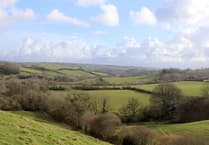The car park near Bedford Bridge was the start point for this walk of between seven and eight miles.
Seventeen members set out to enjoy the sunshine and the wealth of industrial history in the area. Bedford bridge was named after the Duke of Bedford whose family became the dominant force in Tavistock in the 16th century following the Dissolution of the Monasteries. Built in 1822 as part of the turnpike toll road between Plymouth to Tavistock the road fell into decline with the opening of the railway in 1859.
By the early 20th century the bridge was known as Magpie Bridge after the nearby Magpie Inn. Nearby are the industrial remains of Wheal Franco copper mine opened in 1823 and closed in 1875. Red colouration in the soil in a nearby stream is also a reminder of the old brickworks in the area.
The group climbed up through woodland to continue along the trackbed of the disused South Devon & Tavistock Railway line built to link Plymouth and Tavistock, extended in 1865 to Launceston.
The start of the line was delayed by the Crimean War but finally, in 1854, construction of the 13-mile broad gauge line from Tavistock to a junction with the South Devon Railway east of Plymouth was authorised with a budget of £160,000. (The recently re-opened Dartmoor line cost £10 million). As well as connecting local communities, the line was strategically important in blocking the incursion by competing narrow gauge companies. The line closed in 1962 and the disused trackway is now part of the 21 mile Drake’s Trail, a multi-use leisure trail linking Tavistock and Plymouth .
The group crossed Brunel’s impressive 19th century Magpie Viaduct which was replaced in 1902 with blue Staffordshire brick although the original brick-built piers can still be seen supported by timber trestles that carried the track bed.
A little further on they passed under Screw Bridge the name a possibly a corruption of Skew, where the bridge over the track was built at an unusually sloped angle. The Drake’s Way continues across Gem Bridge which spans the River Walkham.
Built to replace the Walkham Viaduct which was demolished in 1965 after the closure of the railway. Gem Bridge was opened in 2012 by Angela Rippon who had lived nearby for 25 years. Before the new bridge was constructed walkers had to descend to the river and cross via a wooden footbridge. Some of the old stonework was rescued to make a picnic area designed by pupils from Whitchurch Primary School. Local children also selected items to go into a time capsule buried under one of the rocks to tell future generations about this corner of Dartmoor in 2012.
Shortly afterwards the walkers turned down onto a steep woodland path towards the river passing through the remains of the Virtuous Lady Copper Mine (thought to be a reference to Queen Elizabeth I). They continued walking in the lush green river valley to their lunch stop at the confluence of the Rivers Walkham and Tavy at Double Waters. From here, another steep climb brought them up to the isolated and little known Berra Tor. This small granite tor, at 132m above sea level is not easy to find hidden amongst trees. The tor is notable for the healthy holly trees sprouting out of the rock.
The group then made their way up to Roborough Down where they enjoyed stunning views of Cox Tor, Roos Tor, Staple Tor and Great Mis Tor. A steep rocky descent brought them down to Horrabridge Station where they rejoined the Drakes Trail to return to their cars.
As ever, new walkers are always welcome. You should be suitably attired for all weather conditions, including sturdy footwear and bring a drink and a packed lunch.
Meet at the post office in George Street, Okehampton on Sundays ready to leave at 9.30am. Next week’s walk will be from Wonson near Chagford.
Members share cars so please be there in plenty of time so the group can leave promptly.
Car drivers with spare seats are encouraged to meet at the post office to offer lifts to non-drivers.




